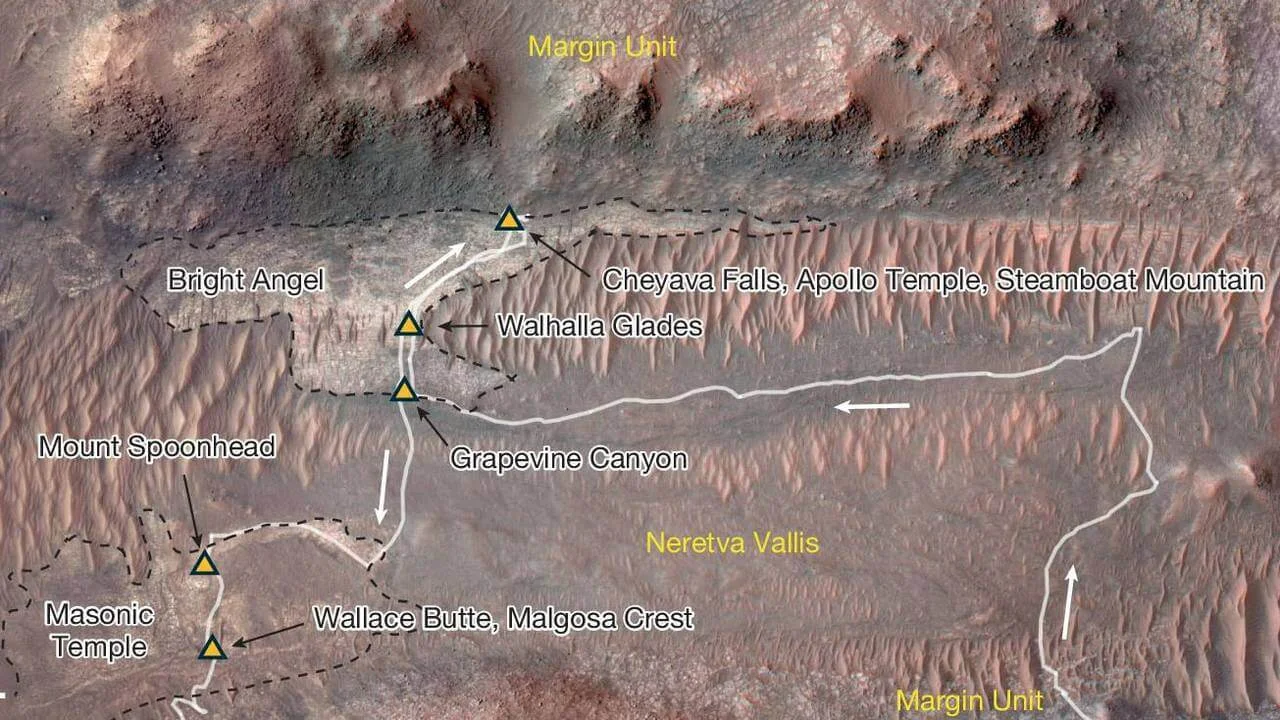Mars’ Jezero Crater Mudstones Reveal Redox Chemistry
Perseverance’s analysis of Jezero Crater mudstones uncovers vivianite nodules and greigite-rich reaction fronts tied to organics, highlighting post-depositional redox cycles on ancient Mars.

Jezero Crater on Mars has long fascinated scientists as a potential relic of an ancient lake. New data from the Perseverance rover focus on the Bright Angel formation, where iron-phosphate and iron-sulfide minerals appear to record low-temperature redox reactions in organic-carbon-bearing mudstones. These findings shed light on past chemical pathways and raise questions about possible biosignatures.
Tracking Perseverance in Neretva Vallis
After landing in Jezero Crater, NASA’s Perseverance rover traversed Neretva Vallis along the crater’s western rim. There it encountered the Bright Angel formation—a set of light-toned, fractured mudstone and conglomerate layers. Instruments including PIXL, SHERLOC, SuperCam, WATSON and Mastcam-Z mapped layer dips up to 30 degrees and revealed metre-scale bedding that lies stratigraphically above the older Margin Unit.
Fine-grained Mudstone and Coarse Intraclastic Debris
Bright Angel rocks share a fine mudstone facies with grain sizes under 100 µm, interspersed with coarser conglomeratic clasts derived from olivine and Fe-Mg carbonates. Spectral data show these mudstones contain silica, aluminosilicate clays and minor hydrated sulfates such as bassanite. In contrast, nearby Western Fan sediments preserve stronger anoxic signatures, marking the Bright Angel rocks as more oxidized on deposition.
Vivianite Nodules Point to Iron-phosphate Authigenesis
Submillimetre “poppy seed” nodules scattered through the mudstone are enriched in Fe, P and Zn and trend toward a 3:2 FeO:P molar ratio. Their colour shifts—blue-green by WATSON, red in decorrelation stretch images—match microcrystalline vivianite (Fe2+3(PO4)2·8H2O) or its oxidation products. Diffraction data confirm fine crystalline domains under 60 µm, pointing to in situ precipitation rather than detrital deposition.
Greigite-bearing Reaction Fronts and Metal-rich Cores
Millimetre-scale “leopard spots” display concentric, dark-toned rims and bleached cores. PIXL mapping of the Apollo Temple and Cheyava Falls targets identifies cores rich in Fe, S, Ni and Zn with an Fe:S ratio near 3:4—consistent with greigite (Fe3S4). Adjacent jarosite and siderite hint at subsequent oxidation stages, while the reaction front rims match Fe-phosphate enrichments.
Organic carbon as a redox driver
SHERLOC Raman spectra reveal a prominent G band near 1 600 cm⁻¹ in Apollo Temple, Walhalla Glades and Cheyava Falls—signals of organic carbon. The intensity of this organic signature inversely correlates with mudstone redness and mudstone oxidation state, indicating that organic carbon oxidation likely fueled Fe³⁺ reduction and vivianite precipitation. Sulfate reduction by organics may have then driven greigite formation in reaction front cores.
Weighing Abiotic and Biological Pathways
Abiotic redox reactions between organic acids and Fe-oxides can generate Fe²⁺ at temperatures up to 80 °C, but require sufficient organic reactants. Magmatic sulfur gases offer another abiotic source of sulfide, though no nearby hydrothermal system is evident. In contrast, microbial analogues on Earth form vivianite and greigite at low temperatures under ferruginous and sulfate-rich conditions—raising the possibility that these Martian minerals could represent potential biosignatures.
Habitable Conditions and Sample Return Prospects
The Bright Angel formation’s fine sediment deposition in water, its redox-driven mineral assemblages, and presence of organics point to ancient habitable environments. While definitive proof of life remains elusive, these textures, chemical patterns and minerals underscore the value of returned samples. The core named Sapphire Canyon, collected from Cheyava Falls, holds promise for high-sensitivity laboratory analyses on Earth that could resolve the origins of these redox features.
This content has been reviewed by subject-matter experts to ensure scientific accuracy. Learn more about us and our editorial process.
Last reviewed on .
Article history
- Latest version
- Last updated by Dayyal Dungrela, MLT, BSc, BS
- Peer reviewed by Dr. Arjun Patel, PhD
Reference(s)
- Hurowitz, Joel A.., et al. “Redox-driven mineral and organic associations in Jezero Crater, Mars.” Nature, vol. 645, no. 8080, 10 September 2025 Nature Publishing Group UK, doi: 10.1038/s41586-025-09413-0. <https://www.nature.com/articles/s41586-025-09413-0>.
Cite this page:
- Posted by Aisha Ahmed